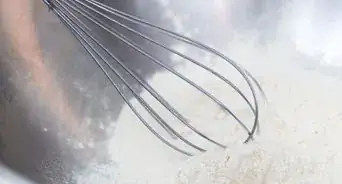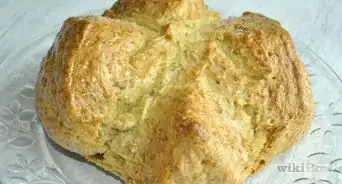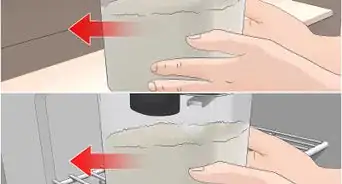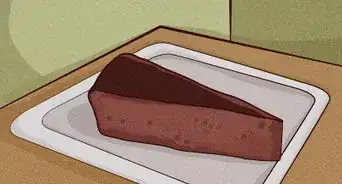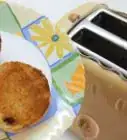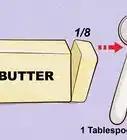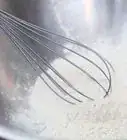This article was co-authored by wikiHow Staff. Our trained team of editors and researchers validate articles for accuracy and comprehensiveness. wikiHow's Content Management Team carefully monitors the work from our editorial staff to ensure that each article is backed by trusted research and meets our high quality standards.
The wikiHow Video Team also followed the article's instructions and verified that they work.
This article has been viewed 47,115 times.
Learn more...
Freshly baked buns are great for having with a wide range of meals and are simple to make. Combine essential bread-making ingredients together—such as yeast, flour, and water—and mix them until they create a smooth consistency. Shape the dough into balls of equal sizes and let them rise before baking them in the oven. After 12-15 minutes of baking, you'll have tasty buns that are ready to be served.
Ingredients
- 5 cups (1,200 ml) all-purpose flour
- 0.25 ounces (7.1 g) dry yeast
- 1 c (240 ml) milk
- 0.75 c (180 ml) water
- 0.5 c (120 ml) vegetable oil
- 0.25 c (59 ml) white sugar
- 1 teaspoon (4.9 ml) salt
Makes 12 buns
Steps
Mixing the Ingredients
-
1Combine 2 cups (470 ml) of flour with 0.25 ounces (7.1 g) of dry yeast in a bowl. Measure out the flour and dry yeast and pour it into a medium-size or large bowl. Use a spoon to stir the 2 ingredients together.[1]
- Make sure you only use 2 cups (470 ml) of the flour during this step as opposed to all 5 cups (1,200 ml). The rest of the flour will be needed later on.
-
2Heat the milk, water, oil, sugar, and salt in a separate bowl. Find a microwave-safe medium-size bowl for the ingredients. Pour 1 c (240 ml) of milk, 0.75 c (180 ml) of water, 0.5 c (120 ml) of vegetable oil, 0.25 c (59 ml) of sugar, and 1 teaspoon (4.9 ml) of salt into the bowl. Put the bowl in the microwave and heat the ingredients on high until they’re lukewarm.[2]
- If you’re not sure how long it will take for the ingredients to heat up, start with 20 seconds.
Advertisement -
3Add the warmed ingredients to the flour mixture. Once the ingredients are sufficiently warm, remove the bowl from the microwave. Carefully pour the warm ingredients into the other bowl containing the flour and yeast.[3]
-
4Beat the combined ingredients for 3 minutes until the consistency is smooth. Use a large spoon to stir all of the ingredients together, making sure there are no huge clumps and that everything is well-distributed. Continue beating the mixture for a few minutes until it forms a smooth consistency.[4]
- If you decide to use a mixer instead of beating the ingredients by hand, you’ll likely not have to mix it for the entire 3 minutes, so pay closer attention to the consistency.
- Start off on a slow speed if using a mixer, and use a dough hook attachment if you have one.
-
5Mix 2–3 cups (470–710 ml) of flour into the mixture to create a soft dough. To make sure you don’t add too much, start by pouring 1 c (240 ml) of flour into the bowl of combined ingredients. Mix the flour in with the ingredients well using a spoon, and then add an additional 1 c (240 ml) of flour until the dough starts to become soft. Add the last 1 c (240 ml) of flour if the dough is still super sticky. Mix everything together well.[5]
- Be careful not to add more than 3 cups (710 ml) of flour to the mixture, as this will likely make your buns way too dense.
Shaping and Baking the Buns
-
1Let the dough rest on a flat surface sprinkled with flour for 10 minutes. Gather a small handful of flour and lightly sprinkle it on a section of clean counter space. Remove the dough from the bowl and set it down on the floured section before placing a large bowl overtop. Let the dough rest under the bowl for 10 minutes.[6]
-
2Shape the dough into 12 balls. Use your hands to form the dough into 12 balls of equal size. You may need to pat some flour on your hands so that the dough doesn’t stick to your hands as you’re shaping it. Press down slightly on the top of each ball so that they’re a little bit flattened.[7]
- Wash your hands with soap and water before shaping the balls.
-
3Set the dough balls on a greased baking sheet. You can grease a baking sheet using butter or use a sheet of parchment paper to cover the baking sheet. Place each dough ball on the baking sheet so that there’s roughly 2 in (5.1 cm) of space separating each ball.[8]
- The dough will expand, which is why it’s important to leave a bit of space between each ball of dough.
-
4Wait 1-2 hours until the dough rises and doubles in size. Make sure you pay attention to how large the balls are before they rise so that you’re able to determine when they’ve doubled. Avoid touching or moving them around while they’re setting.[9]
- Let the dough rise at room temperature.
-
5Bake the dough at 400 °F (204 °C) for 12-15 minutes in the oven. Let the oven preheat fully before putting the buns in the oven. Once the dough balls have risen, place the baking sheet in the oven and let them bake for 12-15 minutes or until the tops of the balls are a light golden brown.[10]
- Once the buns have baked, let them cool for a few minutes on the baking sheet before slicing them in half and serving.
- To store extra buns, place them in a sealed plastic bag, getting as much of the air out as possible.
- The buns should last roughly 5-7 days at room temperature, or you can store them in the freezer for several months. Make sure the bag is marked as freezer-safe.
Altering the Recipe by Preference
-
1Apply honey butter to the tops of the rolls once they're baked. Mix a softened stick of butter with a few spoonfuls of honey, adding a little bit of each ingredient until you're satisfied with the taste. Stir the mixture thoroughly and then use a silicone basting brush to apply the honey butter to the tops of the buns once they're already baked.[11]
- This will give the buns a sweeter taste.
-
2Substitute regular flour for bread flour for chewier buns. Instead of using 5 cups (1,200 ml) of all-purpose flour, purchase bread flour and use this in the recipe instead. This should make your dough less sticky and simple to mold, and your buns will come out with a soft yet chewier texture.[12]
- Keep the rest of the measurements the same.
-
3Add 1 or 2 eggs for richer flavor. If you add eggs, this will make the recipe stickier due to the added liquid, so you'll want to add a bit more flour as well to balance it out. Eggs add a delicious richness to the buns, though they may bake to come out a little bit more flat.[13]
- Start by adding roughly 0.5 c (120 ml) of flour to the recipe.
-
4Use a combination of whole wheat and regular flour for a healthier alternative. Unless you're already used to the flavor of whole wheat flour, avoid substituting all of the regular flour. Instead, try using 50% whole wheat flour and 50% all-purpose flour, following the rest of the recipe to create tasty, healthier buns.[14]
- For example, you might use 1 c (240 ml) of regular flour and 1 c (240 ml) of wheat flour when combining the flour with the dry yeast.
Community Q&A
-
QuestionCan I add 12 cups of sugar for a family sized batch?
 Kane s. FurthersfordCommunity AnswerIt all depends on the amount of flour you put in, but for a family sized batch, that sounds about right.
Kane s. FurthersfordCommunity AnswerIt all depends on the amount of flour you put in, but for a family sized batch, that sounds about right.
Things You'll Need
- 2 large bowls
- 1 medium-size microwave-safe bowl
- Spoon
- Measuring cups
- Baking sheet
- Parchment paper (optional)
- Knife
References
- ↑ https://www.allrecipes.com/recipe/6761/tasty-buns/
- ↑ https://www.allrecipes.com/recipe/6761/tasty-buns/
- ↑ https://www.allrecipes.com/recipe/6761/tasty-buns/
- ↑ https://www.allrecipes.com/recipe/6761/tasty-buns/
- ↑ https://www.allrecipes.com/recipe/6761/tasty-buns/
- ↑ https://www.allrecipes.com/recipe/6761/tasty-buns/
- ↑ https://www.allrecipes.com/recipe/6761/tasty-buns/
- ↑ https://www.allrecipes.com/recipe/6761/tasty-buns/
- ↑ https://www.allrecipes.com/recipe/6761/tasty-buns/


